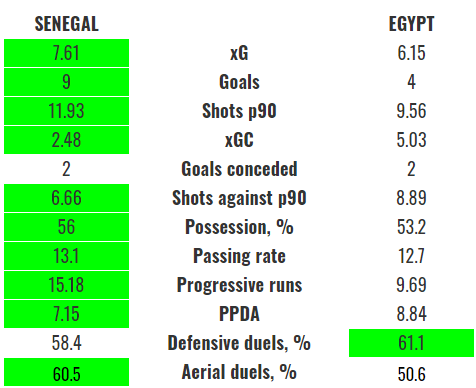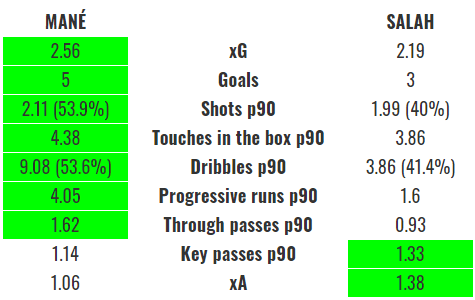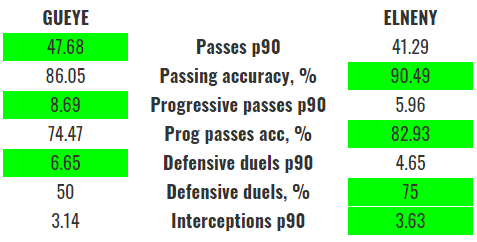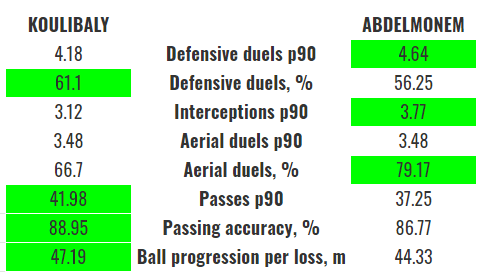After an exciting tournament with plenty of surprises, epic moments and great stories, AFCON 2021 comes to an end on Sunday with the final between Senegal and Egypt.
The Senegalese, who are in the final for the second time in a row, have never won the AFCON, losing the previous final in 2019 against Algeria and the 2002 one against Cameroon. On the opposite side, the Egyptians have won more AFCONs than anyone else (7) but haven’t been able to repeat that since 2010.
Senegal, led by the former PSG or Birmingham player Alou Cissé, beat Burkina Faso comfortably (3-1). Egypt, under former Man United coach Carlos Queiroz, struggles against the hosts Cameroon and after a 0-0 draw, they went through on penalties (3-1). It was Egypt’s third extra time and second penalty shoot-out in the tournament, which gives us an idea of how difficult it has been for them to advance.
In this preview of the final, we’ll use data analysis to address both team’s tactics and the key battles in every part of the pitch.
Senegal v Egypt: opposite sensations in the finalists

Senegal and Egypt were among the favourites to win the AFCON 2021 at the start of the tournaments and they must have done something well to get to the final but both teams’ trajectory has been quite different.
Senegal have been a dominating side and their dominance on paper has translated into the pitch. The Lions of Teranga have scored a total of 9 goals (8 of them in the knock-out stage) from 7.61 xG with their 11.93 shots per 90, which is much better than Egypt’s 4 goals from 6.15 xG. Even if The Pharaohs have produced more than they have scored (they should have scored more than double), they still don’t match Senegal’s output in attack.
In defence, both teams have conceded just 2 goals. Egypt have been lucky as rivals have produced 5.03 xG against them. Senegal are also conceding less than expected but not the difference isn’t as big as Egypt’s as they were expected to concede just 0.48 more goals than they did in the tournament so far.
Senegal concede fewer shots (6.66 per 90 vs Egypt’s 8.89) even if they aren’t as good in defensive duels (they win 58.4% compared to Egypt’s 61.1%). In the air, Senegal are much stronger, winning 60.5% of their aerial duels while Egypt win just 50.6%. This dominance in the air means Senegal are less vulnerable in crosses and set-pieces.
In terms of possession, both teams are used to dominating it. Senegal have an average possession of 56% and they press more intensely than Egypt with just 7.15 PPDA (passes allowed per defensive action). It seems like Egypt are forced to dominate as their rivals sit back and defend but they don’t look to do it all the time and will probably let Senegal have the ball.
Another big difference between both teams is their dribbling and ball-carrying ability. Senegal have several players who excel at getting past players and driving the ball forward as seen in their 15.18 progressive runs per 90. Egypt rely more on passes to progress and they don’t have many dribblers, which translates into just 9.69 progressive runs per 90.
Most of the data is in favour of Senegal for the AFCON 2021 final. They’re more dominant both as a team and individually and look more solid both in attack and defence than the Egyptians. Anything could happen in a final between two top teams like Senegal and Egypt but looking at the statistics so far, Senegal are the favourites.
In the next sections of this data analysis, we’ll preview some of the clashes between the stars of both nations in attack, midfield and defence.
Mané v Salah: the Liverpool clash

Leading the attacks of both teams, we find the Liverpool duo of Sadio Mané and Mohamed Salah. Both EPL stars haven’t shined as much as expected in the AFCON 2021 so far but they’re still arguably the best two African players in the world and they’ll be the main threat of their teams in the final.
Mané’s tournament so far has been more positive than Salah’s. The Senegalese has scored 5 goals, which is 56% of his team’s total, from just 2.56 xG. He’s been clinical in front of the goal and has made the most out of his 2.11 shots per 90.
On the other side, Salah has only scored 3 goals but that’s 75% of his team’s output. He’s also scoring more than expected but not on Mané’s level as he has a total of 2.19 xG so far. He’s also shooting less (1.99 shots per 90) and with less accuracy (40%) than his Liverpool teammate. Egypt have been less dominant and that also shows in Salah being less active in dangerous areas with 3.86 touches in the box per 90 (Mané has 4.38).
In terms of creating chances, Salah has been better than Mané, being the main creative force of Egypt instead of finishing the attacks. With 1.33 key passes per 90, he has assisted a total of 1.38 xG. Mané has been much better at progressing by himself and dribbling and his 4.05 progressive runs per 90 more than double Salah’s 1.6.
Both players have had their ups and downs so far in the tournament. Mané has been more decisive but his role is also more focused on finishing his team’s attacks while Salah has been in charge of creating chances more often. Both of them should be key for their nations in their quest to win the AFCON 2021.
Gueye v Elneny: midfield balance

In midfield, the battle will be between two players that know each other well. PSG’s Idrissa Gueye and Arsenal’s Mohamed Elneny have been excellent so far in the AFCON 2021, dominating games both in defence and attack and being key for their sides.
On the ball, both players are very involved in the build-up and distribution. Playing for a slightly more possession-dominant team, Gueye has more passes per 90 (47.68) than Elneny (41.29) but the difference isn’t great. In terms of their overall passing accuracy, Elneny tends to play safer passes and he completes 82.93% of his passes, which is higher than Gueye’s 86.05%.
Both Gueye and Elneny are also important in their team’s ball progression. Gueye attempts more progressive passes (8.69 per 90) than Elneny (5.96) but completes just 74.47% of them while Elneny completes 82.93%. In total, Gueye completes around 1.5 more progressive passes per 90 than Elneny.
In terms of defensive duels, they win almost the same per 90 (Gueye 3.33 and Elneny 3.49 per 90) but do that differently. Despite his team having more the ball, Gueye is much more engaged in defensive duels, getting into 6.65 of them per 90 but he wins just 50% of them. Elneny isn’t as active (4.65 defensive duels per 90) but is much more effective, winning 75% of them. This difference can also be seen in Elneny achieving 0.49 more interceptions per 90 than Gueye.
Even if both midfielders are seen as mostly defensive, they have accepted and excelled in a more offensive role with their national teams. With their experience at the highest level, they’re the engines of their team’s midfield and make sure the attacks are fluid while holding the team together in defence.
Koulibaly v Abdelmonem: old and new leaders

In defence, we find the duel between players with very different backgrounds. On the Senegalese side, Kalidou Koulibaly is one of the most valuable centre-backs in the world and the leader of his team’s defensive line. On the Egyptian side, Hegazy’s injury has left them without their best defender so the 23-year-old Al Ahly centre-back Mohamed Abdelmonem will need to step up and take that leadership role. He has played 572 minutes so far in the AFCON but only had 2 caps before the tournament so the final will be a key moment for him.
As it’s normal playing in a team that defends more, Abdelmonem gets into 0.46 more defensive duels per 90 than Koulibaly. However, the Napoli centre-back wins 61.1%, which is considerably more than Abdelmonem’s 56.25%. Something similar happens with interceptions, with the Al Ahly defender having 0.65 more per 90.
In the air, both players contest the same number of duels (3.48 per 90) but Abdelmonem is much better, winning 79.17% of the for Koulibaly’s 66.7%. As we saw in the first section of this data analysis, Senegal are a strong team in the air so having a dominant player like Abdelmonem who can defend against that is a big positive for Egypt.
In terms of building up and progressing, Koulibaly looks slightly better than Abdelmonem. The Senegalese attempts 4.73 more passes per 90 and completes 88.95% of them for Abdelmonem’s 86.77%. In terms of progressing, we have chosen to compare meters progressed with passes per loss, which is a good metric to see not only how aggressive they’re with his passes but also how effective. Koulibaly advances just 2.86 meters more per loss than Abdelmonem, which is a very small difference.
Koulibaly is a higher-quality centre-back at the moment but Abdelmonem’s rise has been very quick in this AFCON and he now has the task of leading the defensive line in the most important match of his career so far. The Egyptian’s aerial ability will be key against a powerful Senegalese side.





Comments